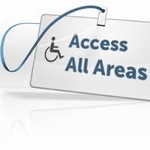Information
-
Building
-
Add media
-
Number of floors
-
Function
-
Date of audit
-
Audited by
SIGNAGE
SIGNAGE
-
Areas intended for the use of people with disabilities are clearly marked with the international symbol of access.
-
Where the international symbol of access displayed at?
- Entrance
- Toilet
- Parking
- Lift
-
International symbol of access has a minimum height of 110mm and with the wheelchair user symbol facing to the right.
-
All signage are consistent, clear, visible and legible.
-
Pedestrian way-finding map and directory provided in external environment.
-
Are the signage over building entrances or on building visible from a distance of 10-15m?
-
Height of lettering at least 50mm or legible from a distance of 15m.
-
Signage has sufficient colour contrast to make the signage clearly legible.
-
Overhead signage have a height clearance of at least 2.1m.
-
Wall mounted signage for the purpose of information located between 1400-1700mm from the floor surface.
PARKING
PARKING
-
No. of designated parking bays.
-
Is there at least one designated parking bay in employee parking area?
-
At least one designated bay per 25 parking spaces in an area of 50 or more parking bays.
-
Is the parking bay at least 3500x5000mm in dimensions?
-
Is the shared space at least 1m in width between two standard bays?
-
Is the parking bay within 50m of the accessible entrance?
-
1000x1000mm International symbol of access clearly demarcated in safety yellow on the floor.
-
Height clearance of 2.4m at entrance/exits and throughout parking area.
-
Vertical signage provided with international symbol of access positioned at least 2m in height from finish floor level.
-
Is there a level access/ drop-kerb from the parking bay to the accessible route/ pavement?
EXTERNAL CIRCULATION
EXTERNAL ENVIRONMENT
-
At least one accessible route is provided within the site from public transport nodes, parking, public streets and pavements.
-
Raised crossing or painted zebra-crossing provided?
-
Is the buildings along the route accessible at least on the ground floor?
-
Accessible route of travel is at least 900mm in width or ideally at 1500mm in width.
-
No revolving doors, revolving gates or turnstile installed at the entrance to the campus/facilities?
-
Is there an alternative entrance at least 900mm wide with a nib of 450mm?
-
Access control system is positioned at 1m above finish floor level.
-
No doors and windows along the route present as obstacles?
-
Are security gates secured to the wall when opened.
-
All overhead obstacles are at least 2m above the floor surface.
-
Any wall mounted fittings or obstacles along the route that are easily visible and contrasting in colour?
-
Is the wall mount fittings and obstacles (dustbins, fire equipment etc) shielded or recessed to prevent injuries?
-
No drainage channels located in pedestrian areas and path of travel?
-
Openings in the floor not exceeding 13mm in width and perpendicular to the direction of travel?
-
Floor chambered at 1:50 slope or 1.1° gradient.
-
Pause areas with suitable seating are provided at 25m intervals.
-
600-800mm warning TGSI install for the full width of the footpath at both ends of vehicular crossings/driveways.
ROAD CROSSING
-
Floor surface are stable, firm and slip resistant .
-
No cobbles or gravels or loose finishes form part of the accessible route.
-
Raised crossing is level with the pavements at both ends.
-
Is the pedestrian crossing clearly marked or painted in white/ safety yellow zebra-crossing stripes?
-
Audible traffic signals provided at both end of the crossing.
-
Does the traffic lights gives priority to pedestrians?
-
Bollards are spaced at least 1000mm in width and not obstructing the accessible route.
-
Kerb ramps slope at 1:8 or 7° gradient.
-
Kerb ramps on both sides of a carriageway are aligned with one another and the direction of travel.
FLOOR SURFACES
FLOOR
-
Floor surface are stable, firm and slip resistant.
-
No opening in the floor exceeding 13mm in width and perpendicular to the direction of travel?
-
Change in level between floor surfaces or thresholds are less than 5mm.
-
No cobbles or gravels or loose finishes form part of the accessible route.
-
Change in floor level exceeding 600mm fitted with a balustrade.
ENTRANCES & DOORS
ENTRANCES & EXITS
-
No. of pedestrain entrances to site
-
No. of accessible entrances.
-
Clear opening width is at least 850mm.
-
Door swing clear of at least 1500x1500mm
-
Closing mechanism allows sufficient time for users to pass through the door.
-
Nib of at least 450mm at handle side of the door.
-
Are there any revolving doors, revolving gates or turnstile at the entrance or along the route?
-
Is there an alternative entrance at least 900mm wide with a nib of 450mm?
-
Access control system are positioned at 1m above finish floor level.
-
Type of door handle in use.
-
Handle positioned at 1000mm above the finish floor
-
Lever door handles at 150mm in length and at 1m in height above floor.
RAMP
RAMPS
-
No. of ramps on site.
Please add a ramp.
-
Ramps located in a convenient locations?
-
Gradient of the ramp is at 1:12 or 5° and 6m in length between landings.
-
Minimum width of ramp is 1100mm.
-
Minimum length of landings at 1200 mm
-
Ø35-50mm handrails at 1m in height on both side of the ramp and continuous between landings.
-
Clear width of 60mm between handrails and wall surface.
-
Handrails extend 300mm at top and bottom of the ramp and return to the supporting structure or finish in a positive return.
-
Handrails are supported centrally from below with a mounting not less than 50mm long.
-
Central handrail is provided at an interval of 2400mm where ramp exceed 2400mm in width.
-
Ramp with a rise exceeding 600mm high have a skirting of 75-300mm to protect users from the edge of the raised surface.
-
Floor surface are stable, firm and slip resistant.
-
Warning tactile guidance provided in accordance with SANS784.
STAIRCASES
STAIRCASES
-
No. of outdoor staircases on site.
-
Please add an outdoor staircase
Outdoor staircase
-
Is outdoor staircase designed to prevent water from accumulating on the walking surface.
-
Width of the staircase at least 900mm in width.
-
Length of landing min 1100mm in length.
-
Risers are consistent and not exceeding 170mm in height.
-
Solid risers.
-
No winders are used along the staircase.
-
Min 40mm contrasting nosing along the width of the tread.
-
Ø35-50mm handrails at 1m in height on both side of the staircases and continuous between landings.
-
Clear width of 60mm between handrails and wall surface.
-
Handrails extend 300mm at top and bottom of the staircase and return to the supporting structure or finish in a positive return.
-
Handrails are supported centrally from below with a mounting not less than 50mm long.
-
Central handrail is provided at an interval of 2400mm where the staircase exceed 2400mm in width.
-
Floor surface are stable, firm and slip resistant.
-
Warning tactile guidance provided in accordance with SANS784.
CONTROLS & SWITCHES
CONTROLS & SWITCHES
-
All light switches and security controls positioned at 1m above finish floor level.
-
Access control system are positioned at 1m above finish floor level.
WARNING SIGNALS
WARNING SIGNALS
-
Emergency control in form of safety beacon with buttons positioned at 1m above finish floor level.
-
Emergency warning system included visible strobe light to warn hearing-impaired people.
-
All emergency warning signals such as smoke detectors, fire alarms and evacuation signals are demonstrated both visually and audibly.
-
All fire controls and fire hydrants are located below 1200mm from the finish floor level and shielded/recessed to prevent injuries.
EXTERNAL LIGHTING
EXTERNAL LIGHTING
-
External areas, parking areas and accessible routes are well lit at 20-50lux for safety and security.
-
Lighting define the entrances and exits of buildings at 100lux.
-
Signage is positioned in well-lit areas or illuminated with backlights.
-
External ramps, stairs and landings are well illuminated at 100lux for safety and security.
-
Flood lights are protected and not part of the accessible routes.
STREET FURNITURE
STREET FURNITURE
-
Public pavements are at least 900mm or ideally at 1500mm in width for pedestrian traffic and Non-Motorised transport.
-
Street lights, traffic lights, bollards and signage posts are positioned between 100-700mm from the kerb edge.
-
All the street furniture are not part of the accessible routes within the site from public transport nodes, parking, public streets and pavements.
-
Any wall mounted fittings or obstacles such as dustbins and bollards along the route are easily visible and contrasting in colour.
-
Bins are colour-coded for recycling with opening at least 1000mm above finish floor level.
-
Bollards are not linked with chains or ropes which present a hazard to visually impaired people.
-
Drinking fountain are clearly identified and easy to use for seated and standing position with the spout height at 750-915mm above the floor.
-
Seating furniture are at least 450mm high and 500mm wide.
LANDSCAPING
LANDSCAPING
-
Tree pits are protected with metal grating at the base with openings not exceeding 13mm.
-
Overhead tree branches have a height clearance of at least 2.1m.
-
No cobbles, gravels, loose finishes or groundcovers form part of any accessible routes.
-
Gravels and loose soil do not spill from planters onto accessible routes.
-
Planters are protected with a solid kerb or suitable edge for cane detection.
-
Landscape irrigation-sprinklers are installed in planter beds and do not water accessible routes.
-
Boardwalks and decks are structurally stable and fitted with balustrade where change in floor level exceeding 600mm.
-
Water features do not obstruct the accessible routes and are protected with a solid kerb or suitable edge for cane detection.
-
Interactive water features are fitted with a stable, firm and slip resistant floor finish.
-
Public artwork do not visually or physically obstruct the accessible routes and are suitably located to aid with orientation.
BUS STOP
BUS STOP
-
Bus shelters design are consistent, visible and clearly identified with appropriate signage.
-
Seating provided at bus shelters.
-
Bus shelters are well lit at 30lux for safety and security.
-
Timetables, routes maps and related public transport information are consistent, clear, visible and legible
-
Signage indicating bus route pick up and drop-off point is clearly indicated.
-
Level access is provided for wheelchair access to bus platform.
-
Parking bays of 2500x14000mm provided for buses.












